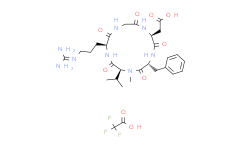| Cas No.: | 199807-35-7 |
| Chemical Name: | Cilengitide TFA salt |
| Synonyms: | Cilengitide trifluoroacetate;Cilengitide (TFA salt);EMD 121974;C29H41F3N8O9;s7077;AK685772;EMD 121974; NSC 707544;A12371;Cilengitide TFA |
| SMILES: | FC(C(=O)O[H])(F)F.O=C1[C@]([H])(C([H])(C([H])([H])[H])C([H])([H])[H])N(C([H])([H])[H])C([C@@]([H])(C([H])([H])C2C([H])=C([H])C([H])=C([H])C=2[H])N([H])C([C@]([H])(C([H])([H])C(=O)O[H])N([H])C(C([H])([H])N([H])C([C@]([H])(C([H])([H])C([H])([H])C([H])([H])/ |
| Formula: | C27H40N8O7 |
| M.Wt: | 702.7 |
| Sotrage: | 2 years -20°C Powder, 2 weeks 4°C in DMSO, 6 months -80°C in DMSO |
| Description: | Cilengitide is a potent and selective integrin inhibitor for αvβ3 and αvβ5 receptor, with IC50 values of 4 nM and 79 nM, respectively. |
| In Vivo: | In nude mice bearing M21-L melanoma tumors, Cilengitide dose i.p. at 10, 50, and 250 μg three times per week demonstrate inhibition of tumor growth with a reduction in both tumor volume (55%, 75%, and 89%, respectively) and tumor weight (23%, 38%, and 61%, respectively), when compared to controls[2]. In the rat model studied, the systemic pharmacokinetics of i.p. Cilengitide are not affected by ILP with Cilengitide alone or ILP with Cilengitide plus Melphalan, TNF or both. Systemic Cilengitide levels reach around 20 µg/mL (approximately 35 µM) within 10 min of i.p. administration and continued to rise to approximately 40 µg/mL (approximately 70 µM) in the first hour. Thereafter Cilengitide levels in serum drop with an elimination half-life of 2.1 hr[3]. |
| In Vitro: | Cilengitide (EMD 121974) is the αvβ3 and αvβ5 integrin receptor antagonist. In cell adhesion studies assessing the human melanoma M21 or UCLA-P3 human lung carcinoma cell lines, Cilengitide inhibits integrin-mediated binding to vitronectin with IC50s of 0.4 and 0.4 μM[1]. In vitro treatment of Cilengitide, at a concentration greater than 1 µM, shows concentration- and time-dependent cytotoxic effects [2]. |

 DC Chemicals' products qualify for U.S. tariff exemptions. We guarantee no price increases due to customs duties and maintain stable supply, continuing to deliver reliable research solutions to our American clients.
DC Chemicals' products qualify for U.S. tariff exemptions. We guarantee no price increases due to customs duties and maintain stable supply, continuing to deliver reliable research solutions to our American clients.





















